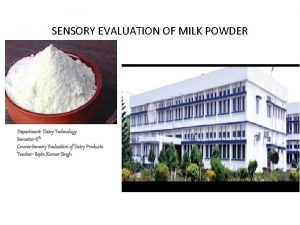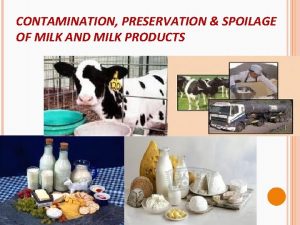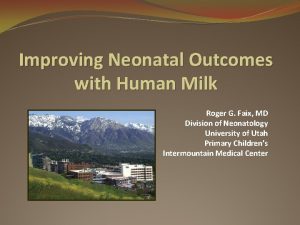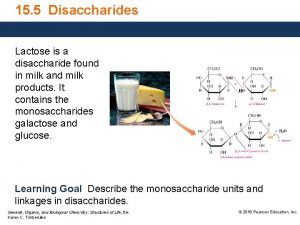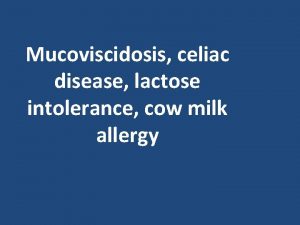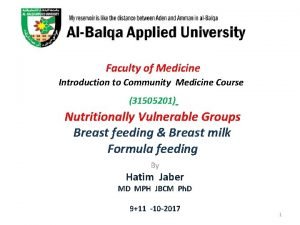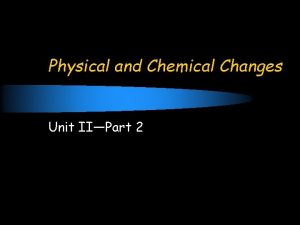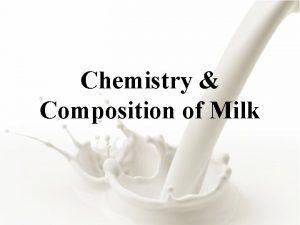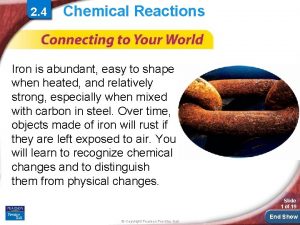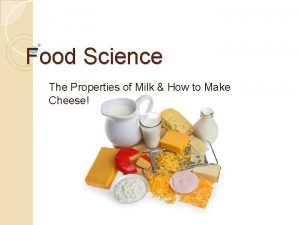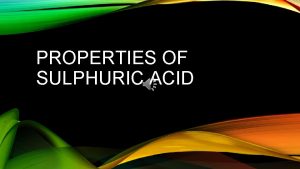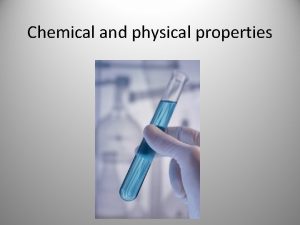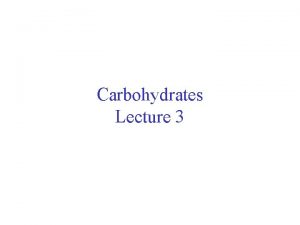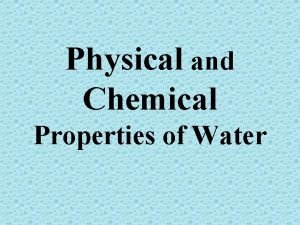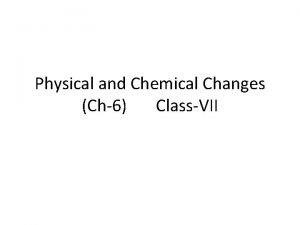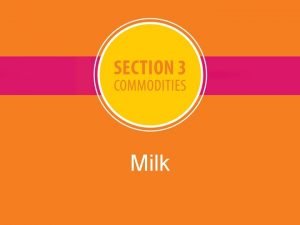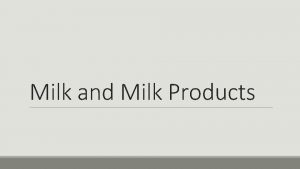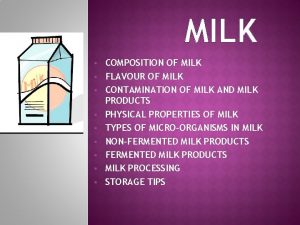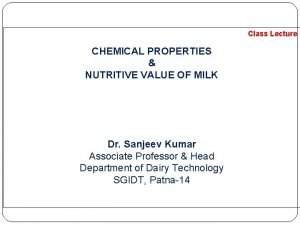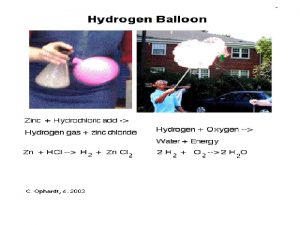Class Lecture CHEMICAL PROPERTIES OF MILK Macro and











































- Slides: 43

Class Lecture CHEMICAL PROPERTIES OF MILK ( Macro and Micro nutrients of Milk) Dr. Sanjeev Kumar Associate Professor & Head Department of Dairy Technology SGIDT, Patna-14

Chemical Properties of Milk • Milk --- true aqueous solution of lactose, salts and a few other minor compounds, which is emulsified with fat and supports a colloidal dispersion of proteins.

Water • Water forms the largest fraction of milk and ranges from 83 -87% • Water content of milk varies from species to species and breed to breed • Water serves as a carrier for the other constituents of milk • A small amount of water in milk is hydrated to lactose and salts and also bound in the proteins.

Fat • Fat - the most commercially significant constituent of milk • Also the most variable fraction in milk • Fat contents varies from breed to breed and also among individuals of the same breed, the variation being caused by many factors • Milk fat - present as a suspension of small globules of varying diameter (cow milk fat: 3 -8 µm, buffalo milk fat: 4 -10 µm) • Fat comprises of different glycerides of low melting point • Composition of fat varies with the feed plan, nutrition, stage of lactation, breed and species, the first being the most important

Fat • Size and number of fat globules vary depending on the breed of the animal and method of milking • Globules become smaller and more numerous as lactation advances • Machine milking produces fat globules of more uniform size than hand milking • Buffalo milk fat -- more easily churned into butter than cow milk fat. • Milk of animals in advance lactation is less suitable for being churned into butter. • Milk fat is quite bland in taste and imparts smoothness and palatability to fat-containing dairy products.

Fat • Mixed glycerides make up to 98 -99% of the milk fat. • Numerous triglycerides may be present in milk fat, since milk contains as many as 64 fatty acids. • Butyric, Caproic, caprylic and capric acids, present in high proportions, -characterized by strong odours and flavour. • Milk fat also contains cholesterol, thus differentiating-- vegetable fats, which contains phytosterols. • Milk contains 0. 1 to 0. 23% phospholipids, viz. lecithin, phosphatidyl serine, sphingomyelin, inositol and cerebrosides

Major fatty acids in milk (in 100 g)

Physical properties of milk fat

Physical properties of milk fat • Four most abundant fatty acids in milk -- myristic, palmitic, stearic and oleic acids • Presence of a high content of high-melting fatty acids, such as palmitic acid, results in harder fat • Fat with a high content of low-melting oleic acid makes soft butter • Melting points of individual triglycerides range from -75 C for tri-butyric glycerol to 72 C for tri-stearin • Nevertheless, the final melting point of milk fat is at 37 C because higher melting triglycerides dissolve in the liquid fat • Trans-unsaturation increases melting points, whereas odd-numbered and branched chains decrease melting points

Chemical properties of milk fat • All fats belong to a group of chemical substances--esters, compounds of alcohols and acids • Milk fat is a mixture of different fatty acid esters --- triglycerides, composed of an alcohol called glycerol and various fatty acids • Fatty acids make up about 90% of milk fat • A fatty acid molecule -- composed of a hydrocarbon chain and a carboxyl group (formula R-COOH). • Saturated fatty acids, such as myristic, palmitic, and stearic constitute two thirds of milk fatty acids • Oleic acid with a single double bond -- the most abundant unsaturated fatty acid in milk

Chemical properties of milk fat • Distribution of fatty acids on the triglyceride chain -- important when determining the physical properties of the lipids • In general, the position 1 binds mostly longer carbon length fatty acids, and the position 3 binds mostly shorter carbon length and unsaturated fatty acids • For example, 97% of C 4 and 84% of C 6 are associated with position 3 whereas 58% of C 18 binds to position 1 • Certain other classes of lipids include phospholipids (0. 8%) and cholesterol (0. 3%), -- mainly associated with the fat globule membrane and core of the in the fat globule, respectively

Creaming • Most of the (> 95%) milk fat exists in the form of globules of 0. 115 m diameter • A thin membrane (8 -10 nm thick) covers these liquid fat droplets • The major components of the native fat globule membrane are protein and phospholipids • Ig. M - an immunoglobulin in milk, forms a complex with lipoproteins. This complex, known as cryoglobulin, precipitates onto the fat globules and causes flocculation. This is known as cold agglutination. Thus cream layer forms very rapidly (within 20 to 30 minutes) in cold raw milk.

Milk proteins • Amino acids form the building blocks of proteins. • Contain both a weak basic amino group, and a weak acidic carboxyl group, both connected to a hydrocarbon chain, which is unique to different amino acids. • Joined together in random order by the peptide linkage to form the polypeptide chains. • May further be cross-linked by disulphide bridges forms -primary structure of proteins. • If the protein - tightly coiled and folded into a somewhat spherical shape, called a globular protein.

Milk proteins • If the protein consists of long polypeptide chains which are intermolecularly linked, - Fibrous proteins. • The caseins, whey proteins and non-protein nitrogen (NPN) make up the nitrogen content of milk. • Caseins : 76% • whey proteins: 18% • Non-protein nitrogen: 6%

Concentration of proteins in milk

Caseins • Casein constitutes about 80% of the total proteins present in milk. It is a phosphoprotein. • The viscosity and white colour of milk are largely due to casein. • All caseins precipitate at p. H 4. 6. Compositionally, -- all conjugated proteins, most with phosphate group(s) esterified to serine residues. • Phosphate groups are important to the structure of the casein micelle. • In addition, calcium binding by the individual caseins is proportional to the phosphate content. • Caseins -- distinguished by the absence of disulphide bonds and a large number of proline residues which cause bending of the protein.

Conti--- • This peculiar bending prevents the formation of a tightly packed secondary structure. • Caseins -- stable to heat denaturation because of the lack of tertiary structure, leading to little structure that will unfold. • Insolubility of caseins in water also --- to the absence of tertiary structure, which results in the exposure of large umber of hydrophobic residues. • Casein micelles aggregate by the action of enzymes, acid, heat or due to age- gelation.

Properties of casein fractions

Whey proteins • Green clear liquid that separates out of milk after precipitation of caseins at p. H 4. 6 --- whey and • Proteins contained therein are whey proteins. • Native whey proteins ---- good gelling and whipping properties. • Denaturation increases their water holding capacity.

Major whey protein fractions

• Beta-lactoglobulin including eight genetic variants, comprises approximately half the total whey proteins • Coagulated by heat, explaining why colostrum curdles when heated • Binds fat soluble vitamins, making them more available to the body and provides an excellent source of essential and branched chain amino acids • Help prevent muscle breakdown and spare glycogen during exercise • May be required in some individual with liver conditions, such as Cirrhosis

• Alpha lactalbumin --- not coagulated by rennet or acids • but precipitated by heat, the extent of coagulation being governed by temperature of holding, salt concentration and p. H of milk • The primary protein found in human breast milk • Alpha lactalbumin -- an excellent source of essential amino acids • Potential benefits include sleep regulation and mood improvement under stress • Only whey protein component capable of binding calcium.

• Immunoglobulins provide non-specific humoral protective effect to the offspring against entero-pathogenic microorganisms. • Predominant colostrum. whey protein component found in • Bovine milk contains only traces of Ig. A. • Bovine serum albumin (BSA) -- a large sized protein with a good essential amino acid profile and fat binding properties.

• Lactoferrin - a red-coloured protein, capable of chelating iron • Inhibits enteropathogenic organisms due to its ability to bind iron, as iron is an essential nutrient often required for bacterial growth • Promotes the growth of beneficial bacteria such as bifidobacteria • Lactoferrin -- an anti-oxidant that naturally occurs in many body secretions such as tears, blood, breast milk, saliva and mucus • Lactoperoxidase and Lysozyme -- enzymes that have antibacterial activities. • Exhibits immunity enhancing properties. • Although lysozyme from egg white - more industrial applications in the past, • Enzyme isolated from human or bovine milk - far greater lytic activity compared to egg lysozyme

Milk enzymes • Milk contains both indigenous and exogenous enzymes • Exogenous enzymes mainly consist of heat-stable lipases and proteinases produced by psychrotropic bacteria • The indigenous enzymes that have been isolated from milk are lipase, aryl esterase, alkaline phosphatase, acid phosphatase, xanthine oxidase, peroxidase, protease, amylase, catalase and lactase ( -galactosidase) • The most significant group is the hydrolases, comprising of lipoprotein lipase, plasmin and alkaline phosphatase • Lipoprotein lipase is found mainly in the plasma in association with casein micelles

Conti-- • Plasmin -- a proteolytic enzyme that attacks both -casein and -s 2 -casein • Very heat stable and responsible for the development of bitterness in pasteurized milk and UHT processed milk • Plays a role in ripening and flavour development of certain cheeses, such as Swiss cheese • Alkaline phosphatase splits specific phosphoric acid esters into phosphoric acid and the related alcohols • Unlike most milk enzymes, --- has a p. H and temperature optima differing from physiological values; p. H of 9. 8 • Enzyme -- destroyed by minimum pasteurization temperatures • Therefore, its absence -- indicator of efficient pasteurization

Non-protein Nitrogenous (NPN) substances Besides proteins, milk contains NPN substances ü ü ü like Amino acids, Creatine, Urea, uric acid, Creatinine and Hipuric acid

Lactose • In addition to lactose, fresh milk contains other carbohydrates in small amounts, including glucose, galactose, and oligosaccharides • Lactose constitutes 4. 8 to 5. 2% of milk, 52% of milk SNF, and 70% of whey solids • Lactose --- the least variable, yet most unstable constituent of milk being quickly fermented by micro-organisms • Lactose -- not as sweet as sucrose. It is a disaccharide (2 sugars) made up of two monosaccharides, glucose and galactose. • Sugar crystallizes in an alpha form and results in the defect called sandiness

Molecular structure of lactose

Vitamins • Essential to normal life processes, but cannot be synthesized by the body • Milk contains the both water and fat soluble vitamins • As milk fat is an important dietary source of vitamin A, low fat products are normally supplemented with vitamin A • Grass feeding enhances its level in the milk • Milk -- fairly good source of water soluble B vitamins such as thiamine (B 1), riboflavin (B 2), niacin(b 3), pantothenic acid (B 5), pyridoxine (B 6) and cyanocabalamin (B 12). • Milk - a poor source of vitamin C (ascorbic acid).

Vitamin content of fresh milk per (100 g)

Minerals • Minerals have many roles in the body including enzyme functions, bone formation, water balance maintenance, and oxygen transport. • Although they constitute less than 1% of milk, they influence the heat stability and clumping of fat globules after homogenization. • All 22 minerals considered essential to the human diet are present in milk. • Milk -- an important source of dietary calcium. • Good source of magnesium, phosphorus, potassium, selenium and zinc.

Minerals • In milk approximately 67% of the calcium, 35% of the magnesium, and 44% of the phosphate are salts bound within the casein micelle and the rest are soluble in the serum phase. • Nutritional availability of calcium and phosphate are not affected by their association with salts and protein. • Milk contains very small amounts of copper, iron, manganese, and sodium and is not consider a major dietary source of these minerals. • Other minerals such as aluminium, boron, zinc, cobalt, iodine, fluorine, molybdenum, nickel, lithium, barium, strontium and silica are also present in milk.

Mineral content of fresh milk (per 100 g)

Buffalo Milk • Buffalos convert poor quality roughages and crop residues into milk more efficiently, thus contributing more significantly towards milk production in India. • Main source of marketable surplus of milk in India is buffalo milk. • Certain unique technological advantages compared to cow milk, because of the innate differences in qualitative and quantitative aspects of various constituents and physico-chemical properties of the two milks.

Gross composition of milk – Buffalo Vs Cow

Buffalo milk fat • Buffalo milk -- richer than cow milk in fat content, which contribute to its unique taste. • Fat globules are larger than those in cow milk. • Average cholesterol content of buffalo milk is 20 mg/100 ml which is significantly higher than that of cow milk. • Buffalo milk has higher proportions of butyric, stearic and palmitic acids and lower levels of caproic, caprylic, myristic and linoleic acids. • Contains higher levels of makeup. tetraenoic and pentaenoic acids in its fat • Total level PUFA and free fatty acids (FFA) are lower than that in cow milk.


Buffalo milk proteins • Buffalo milk protein is particularly rich in casein and whey proteins. • The proportions of protein fractions, however, are similar in milk of both species. • Almost all the casein in buffalo milk (94. 8%) is in micellar form. • The casein micelle size is large and varies from 80 -250 nm in contrast to cow milk where the casein micelle size ranges from 70 -110 nm. • Buffalo milk is richer in lactoferrin content than cow milk. Raw buffalo milk exerts greater inhibitory action on growth of bacteria than cow milk, which is attributed to higher lactoferrin content of buffalo milk.

Buffalo milk vitamins and minerals • Buffalo milk contains similar contents of vitamins and higher levels of minerals than cow milk.

Buffalo milk vitamins and minerals

Enzymes in Buffalo Milkmilk • Contains lower concentration (one third) of alkaline phosphatase than cow milk. The activity of the enzyme in buffalo milk is ~ 0. 12 -0. 18 units/ml. • Buffalo milk has slightly lower lipase activity (13. 2 units) as compared to 17. 2 units in cow milk. • Nearly 24% higher peroxidase activity than cow milk. • The thermal stability of buffalo milk lactoperoxidase --- also higher than that of cow milk. • Lysozyme content of buffalo milk--- 15. 2 mg/100 ml which is lower than cow milk.

Thank you
 Sensory evaluation of milk and milk products
Sensory evaluation of milk and milk products Contamination of milk and milk products
Contamination of milk and milk products Milkbankcolorado
Milkbankcolorado Disaccharide found in milk and milk products
Disaccharide found in milk and milk products Chemical property of water
Chemical property of water Milk for toddlers with milk allergynon dairy
Milk for toddlers with milk allergynon dairy Human milk vs cow milk
Human milk vs cow milk Happy
Happy Single pass macro processor
Single pass macro processor 01:640:244 lecture notes - lecture 15: plat, idah, farad
01:640:244 lecture notes - lecture 15: plat, idah, farad Is separating sand from gravel a physical change
Is separating sand from gravel a physical change Separating sand from gravel chemical or physical
Separating sand from gravel chemical or physical Milk chemistry
Milk chemistry Chemical change of milk
Chemical change of milk Chemical change of milk
Chemical change of milk Chemical change of milk
Chemical change of milk Chemical change of milk
Chemical change of milk Is whipping cream a chemical change
Is whipping cream a chemical change Is toast a physical or chemical change
Is toast a physical or chemical change Colligative properties of milk
Colligative properties of milk Chapter 7 review chemical formulas and chemical compounds
Chapter 7 review chemical formulas and chemical compounds Modern chemistry chapter 7 review answers
Modern chemistry chapter 7 review answers Properties of sulphuric acid
Properties of sulphuric acid Ethan is observing chemical and physical properties
Ethan is observing chemical and physical properties Thermal conductivity in dentistry
Thermal conductivity in dentistry Physical property
Physical property Physical and chemical properties of helium
Physical and chemical properties of helium Chemical properties and changes lesson 4
Chemical properties and changes lesson 4 Physical and chemical properties of boron
Physical and chemical properties of boron Chemical properties of aldehydes and ketones
Chemical properties of aldehydes and ketones Physical and chemical properties interactive
Physical and chemical properties interactive Physical properties of sodium
Physical properties of sodium Hemiacetal group in maltose
Hemiacetal group in maltose Physical properties
Physical properties Water chemical and physical properties
Water chemical and physical properties Physical and chemical properties sorting activity
Physical and chemical properties sorting activity Extensive properties and intensive properties
Extensive properties and intensive properties Class 7 chemical and physical change
Class 7 chemical and physical change Section 2 classifying chemical reactions
Section 2 classifying chemical reactions Section 2 classifying chemical reactions worksheet answers
Section 2 classifying chemical reactions worksheet answers Section 1 chemical changes
Section 1 chemical changes Chapter 18 chemical reactions balancing chemical equations
Chapter 18 chemical reactions balancing chemical equations Properties of isomers
Properties of isomers Slidetodoc
Slidetodoc
